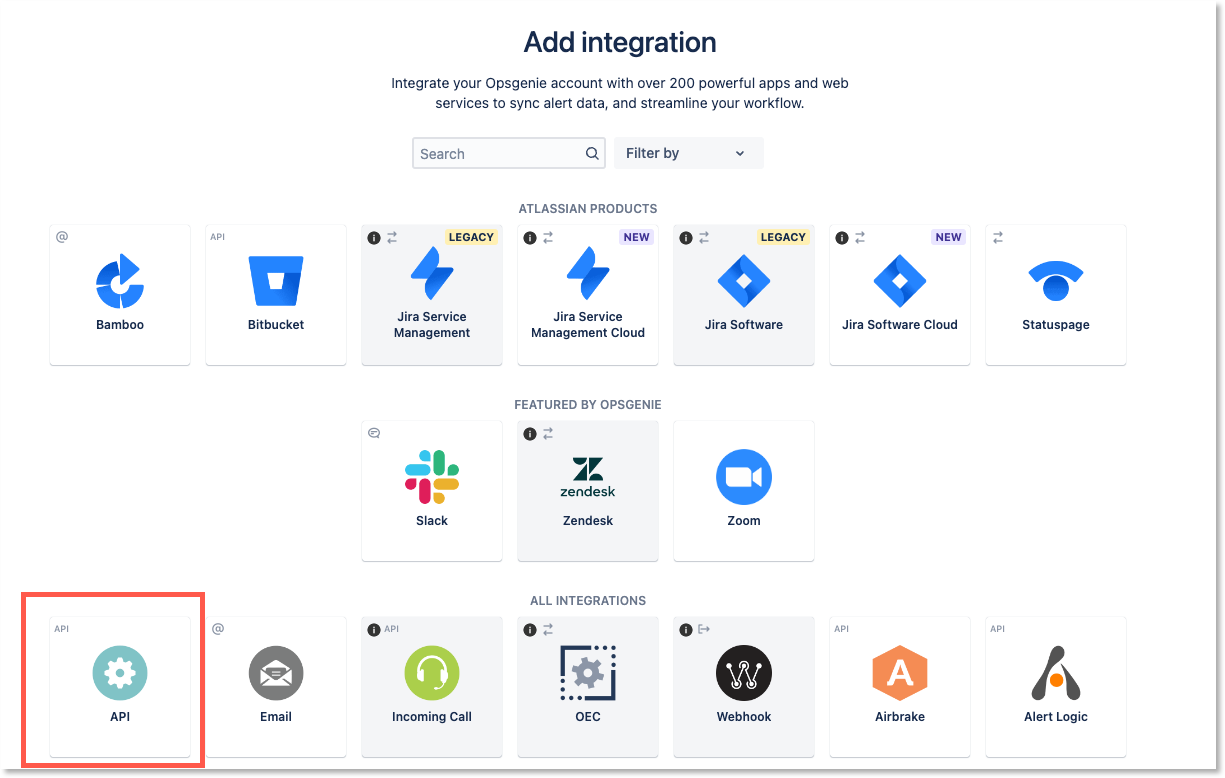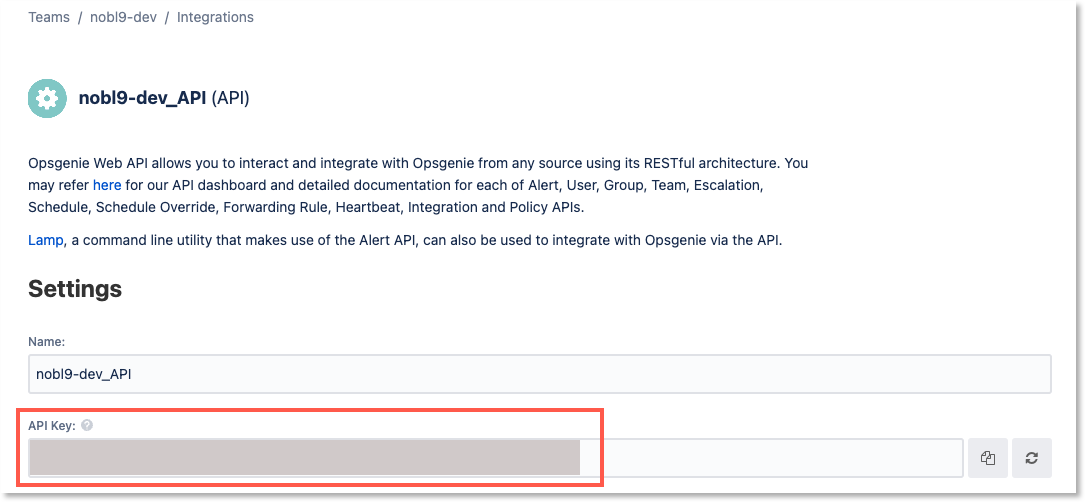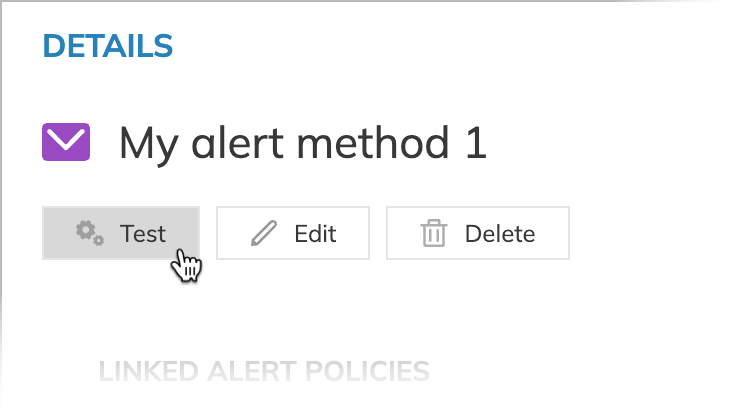OpsGenie alert method
The OpsGenie alert method sends alerts through Opsgenie to notify whenever an incident is triggered.
Authentication
Two authentication methods are supported for Opsgenie API integration:
-
Basic is a base64 hash created from the API Key, for example,
YTU5ODNiZjYtZTM3OC00Yzk3LWE2YWItOGJlMzU4OWUxOTBm. -
GenieKey (default) only requires the API Key obtained directly from the Opsgenie panel, so it is easier to use.
The choice between the two authentication methods is offered for convenience, as some users may only have access to one of the methods.
Creating Opsgenie API Key
-
Log in to your Opsgenie account.
-
Go to Teams in the top navbar, then click the Add team button:

- Hover over and click the name of the team that you've created:

- Go to Integrations in the left sidebar, and click the Add integration button:

- Click the API icon:

- Copy your Opsgenie API Key:

Known limitations
Currently, Nobl9 doesn't return the severity level when an OpsGenie alert is triggered.
Adding the OpsGenie alert method
Alternatively, utilize the SLOs-as-code approach by:
- Applying an alert method YAML configuration with the
sloctl applycommand. - Configuring the OpsGenie alert method definition programmatically using the Nobl9 Terraform provider.
Nobl9 Web
To set up the alert method in the Nobl9 UI, follow these steps:
- Navigate to Integrations > Alert methods.
- Click
.
- Select OpsGenie.
-
Enter the URL (mandatory).
The URL must start withhttps://api.opsgenie.comorhttps://api.eu.opsgenie.com. -
Choose the Authentication Method (mandatory).
GenieKey is selected by default. For more information, refer to the Authentication section. -
Enter the API Key (mandatory).
Paste the API Key from Opsgenie. For more information, refer to the Authentication section.
- Select a Project (mandatory).
Project is a way to organize your Nobl9 resources and manage access to them.
When Project is skipped, Nobl9 uses thedefaultproject. - Enter a Display Name (optional).
Spaces are allowed. - Enter a Name (mandatory).
The name is mandatory and can only contain lowercase, alphanumeric characters, and dashes (for example,my-alert-method-1). Nobl9 duplicates the display name here, transforming it into the supported format, but you can edit the result. - Enter a Description (optional).
Provide extra details about it, its purpose, responsible persons, etc.
Up to 1050 characters.
- Click Add alert method
OpsGenie alerts severity mapping
OpsGenie returns priority levels, which Nobl9 maps to its own severity levels for consistency in handling alerts. Below is the mapping of Nobl9 severity levels to the priority levels returned by OpsGenie:
| OpsGenie Priority | Nobl9 Severity |
|---|---|
| P5 | Low |
| P3 | Medium |
| P1 | High |
YAML configuration for Opsgenie
- General YAML
- Example with GenieKey auth
- Example with basic auth
apiVersion: n9/v1alpha
kind: AlertMethod
metadata:
name: string # Mandatory
displayName: string # Optional
# Optional
# The key value: only alphanumeric characters, `-`, `_`, or `.` are allowed.
# The key value must start and end with an alphanumeric character.
# An optional DNS subdomain prefix followed by `/` is allowed.
annotations:
key: value
spec:
description: string # Optional
opsgenie:
auth: string # Mandatory. One of: GenieKey with key | Basic with token
url: string # Mandatory
# Opsgenie Alert Method with Basic
- apiVersion: n9/v1alpha
kind: AlertMethod
metadata:
name: opsgenie
displayName: Opsgenie Alert Method
project: default
annotations:
area: latency
env: prod
region: us
team: sales
spec:
description: Example Opsgenie Alert Method
opsgenie:
auth: Basic 123
url: https://api.opsgenie.com
# Opsgenie Alert Method with GenieKey
- apiVersion: n9/v1alpha
kind: AlertMethod
metadata:
name: opsgenie
displayName: Opsgenie Alert Method
project: default
annotations:
area: latency
env: prod
region: us
team: sales
spec:
description: Example Opsgenie Alert Method
opsgenie:
auth: GenieKey 123
url: https://api.opsgenie.com
- apiVersion: n9/v1alpha
kind: AlertMethod
metadata:
name: opsgenie-basic-auth
displayName: Opsgenie Alert Method with Basic auth
project: default
annotations:
area: latency
env: prod
region: us
team: sales
spec:
description: Example Opsgenie Alert Method with Basic auth
opsgenie:
auth: Basic 123
url: https://api.opsgenie.com
Testing the Opsgenie alert method in the UI
- Navigate to Integrations > Alert methods.
- Click the required alert method.
Its Details page opens. - Click Test under the alert method name:

- When the configuration is correct, Nobl9 displays Test completed successfully! under the button.
- Otherwise, the Test failed message appears. It contains the details of incorrect settings.

